Managing Business Activities to Achieve Results: Morrison Report
VerifiedAdded on 2019/12/28
|21
|6853
|173
Report
AI Summary
This report provides a detailed analysis of managing business activities, using Morrison Supermarkets as a case study. It explores the interrelationship between different organizational processes and functions, mapping these processes to the organization and evaluating their outputs. The report outlines a plan to promote goals and objectives, including the use of SMART objectives to align people and resources. It also examines the implementation of appropriate systems, effective monitoring and control, and systems to manage and monitor quality standards. Furthermore, the report delves into demonstrating the quality culture of the organization, recommending improvements, and considering the wider implications of proposed changes. It concludes with a focus on carrying out risk assessments, demonstrating the applicability of health and safety regulations, and reviewing organizational health and safety policies, along with practical applications in the workplace.
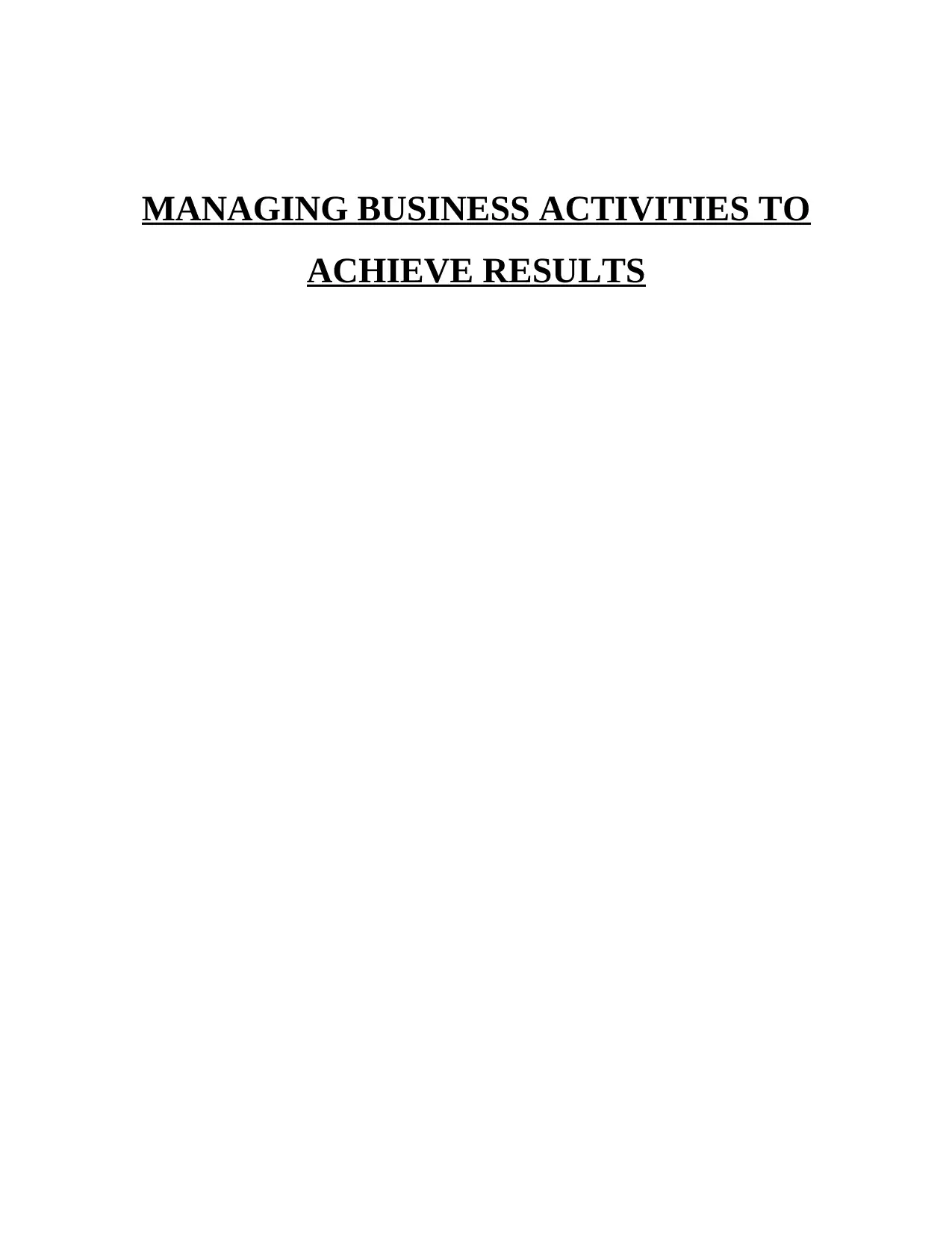
MANAGING BUSINESS ACTIVITIES TO
ACHIEVE RESULTS
ACHIEVE RESULTS
Paraphrase This Document
Need a fresh take? Get an instant paraphrase of this document with our AI Paraphraser
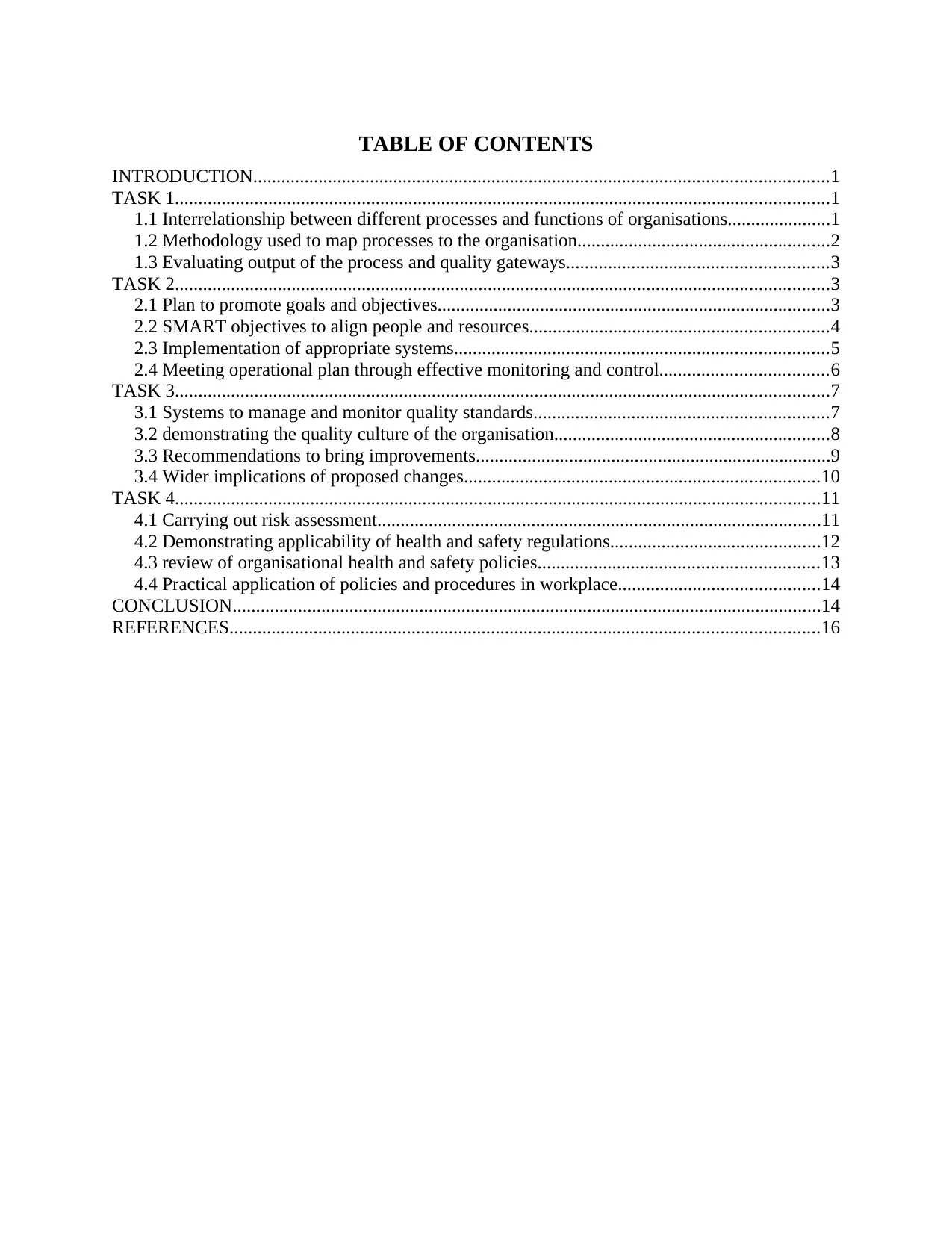
TABLE OF CONTENTS
INTRODUCTION...........................................................................................................................1
TASK 1............................................................................................................................................1
1.1 Interrelationship between different processes and functions of organisations......................1
1.2 Methodology used to map processes to the organisation......................................................2
1.3 Evaluating output of the process and quality gateways........................................................3
TASK 2............................................................................................................................................3
2.1 Plan to promote goals and objectives....................................................................................3
2.2 SMART objectives to align people and resources................................................................4
2.3 Implementation of appropriate systems................................................................................5
2.4 Meeting operational plan through effective monitoring and control....................................6
TASK 3............................................................................................................................................7
3.1 Systems to manage and monitor quality standards...............................................................7
3.2 demonstrating the quality culture of the organisation...........................................................8
3.3 Recommendations to bring improvements............................................................................9
3.4 Wider implications of proposed changes............................................................................10
TASK 4..........................................................................................................................................11
4.1 Carrying out risk assessment...............................................................................................11
4.2 Demonstrating applicability of health and safety regulations.............................................12
4.3 review of organisational health and safety policies............................................................13
4.4 Practical application of policies and procedures in workplace...........................................14
CONCLUSION..............................................................................................................................14
REFERENCES..............................................................................................................................16
INTRODUCTION...........................................................................................................................1
TASK 1............................................................................................................................................1
1.1 Interrelationship between different processes and functions of organisations......................1
1.2 Methodology used to map processes to the organisation......................................................2
1.3 Evaluating output of the process and quality gateways........................................................3
TASK 2............................................................................................................................................3
2.1 Plan to promote goals and objectives....................................................................................3
2.2 SMART objectives to align people and resources................................................................4
2.3 Implementation of appropriate systems................................................................................5
2.4 Meeting operational plan through effective monitoring and control....................................6
TASK 3............................................................................................................................................7
3.1 Systems to manage and monitor quality standards...............................................................7
3.2 demonstrating the quality culture of the organisation...........................................................8
3.3 Recommendations to bring improvements............................................................................9
3.4 Wider implications of proposed changes............................................................................10
TASK 4..........................................................................................................................................11
4.1 Carrying out risk assessment...............................................................................................11
4.2 Demonstrating applicability of health and safety regulations.............................................12
4.3 review of organisational health and safety policies............................................................13
4.4 Practical application of policies and procedures in workplace...........................................14
CONCLUSION..............................................................................................................................14
REFERENCES..............................................................................................................................16
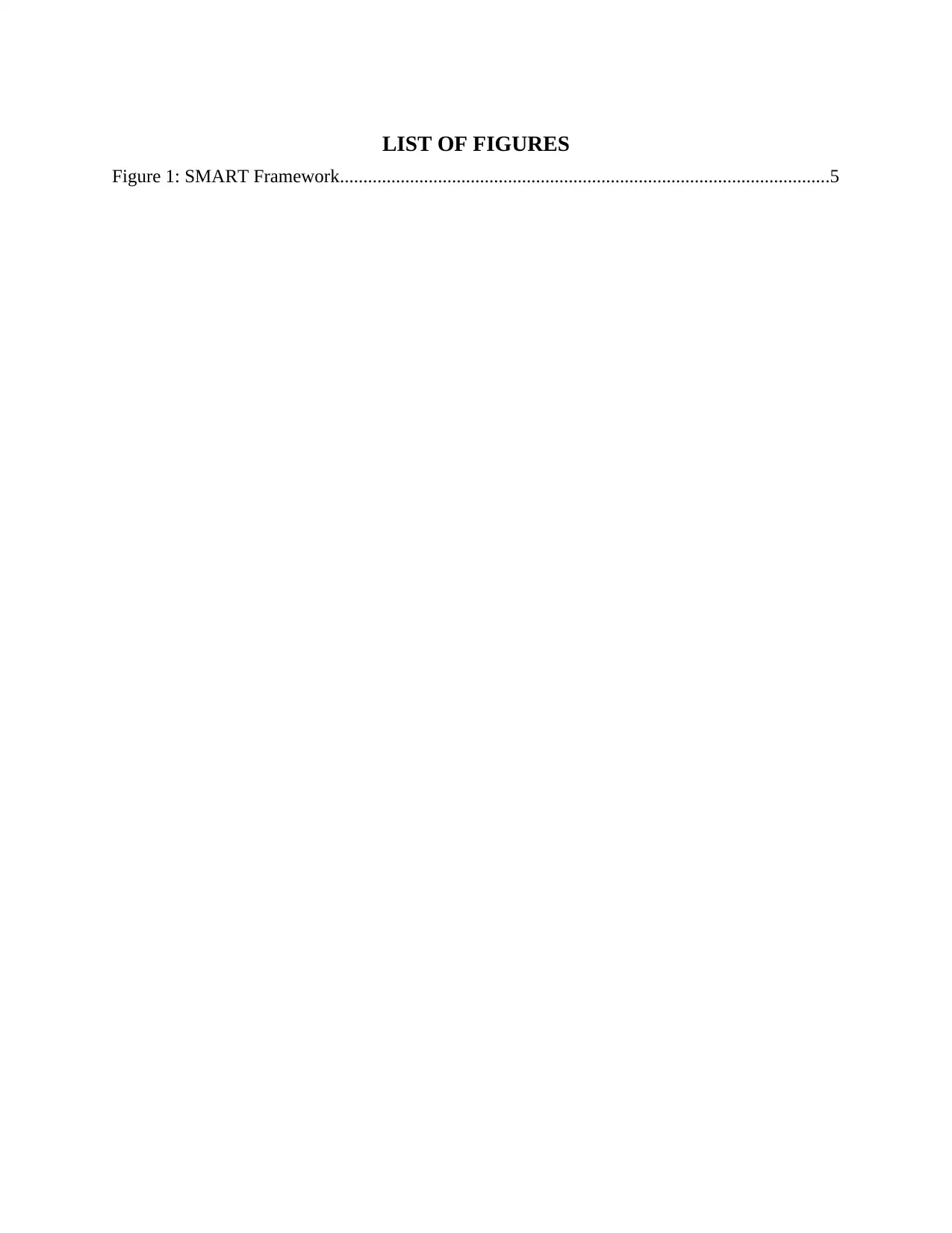
LIST OF FIGURES
Figure 1: SMART Framework.........................................................................................................5
Figure 1: SMART Framework.........................................................................................................5
⊘ This is a preview!⊘
Do you want full access?
Subscribe today to unlock all pages.

Trusted by 1+ million students worldwide
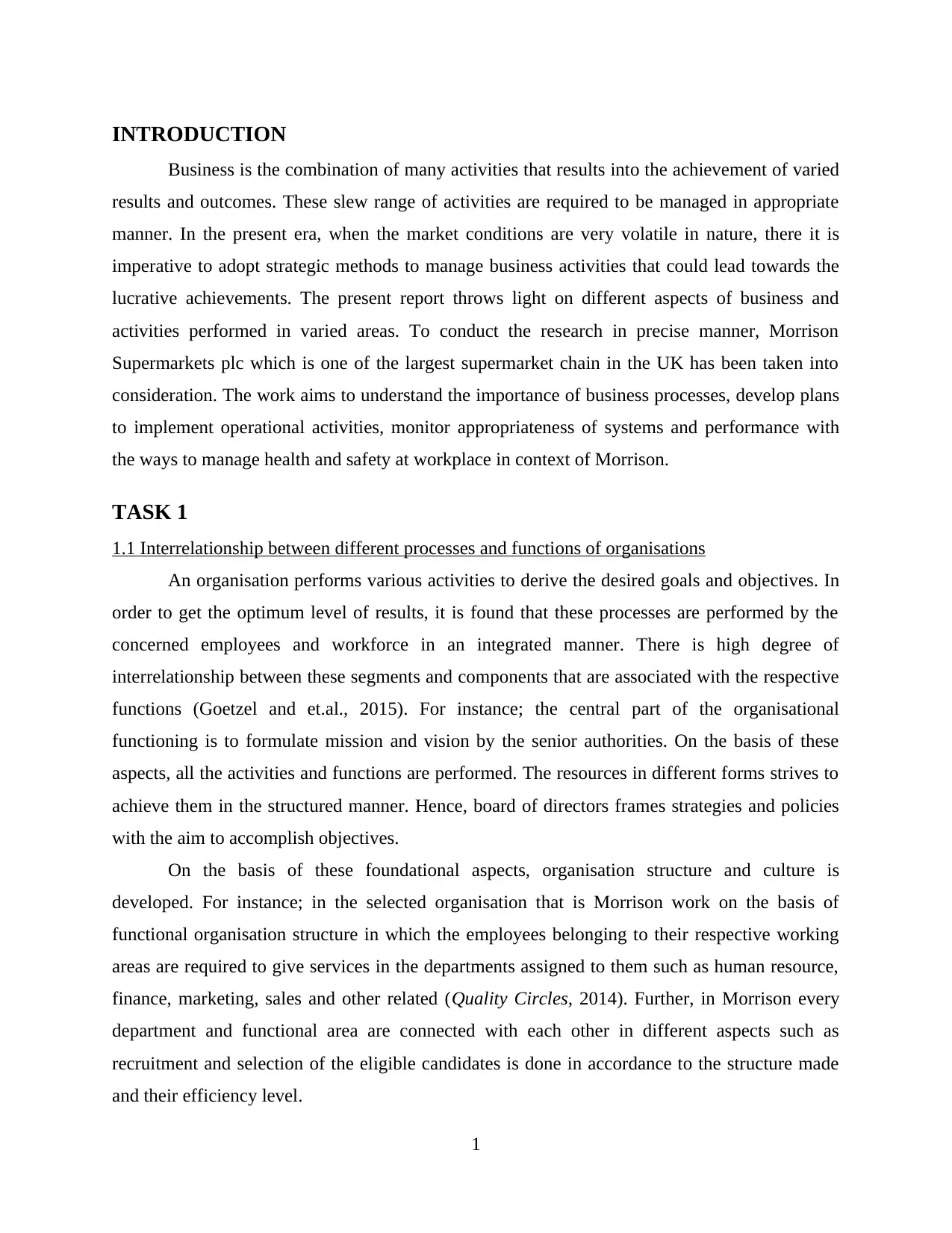
INTRODUCTION
Business is the combination of many activities that results into the achievement of varied
results and outcomes. These slew range of activities are required to be managed in appropriate
manner. In the present era, when the market conditions are very volatile in nature, there it is
imperative to adopt strategic methods to manage business activities that could lead towards the
lucrative achievements. The present report throws light on different aspects of business and
activities performed in varied areas. To conduct the research in precise manner, Morrison
Supermarkets plc which is one of the largest supermarket chain in the UK has been taken into
consideration. The work aims to understand the importance of business processes, develop plans
to implement operational activities, monitor appropriateness of systems and performance with
the ways to manage health and safety at workplace in context of Morrison.
TASK 1
1.1 Interrelationship between different processes and functions of organisations
An organisation performs various activities to derive the desired goals and objectives. In
order to get the optimum level of results, it is found that these processes are performed by the
concerned employees and workforce in an integrated manner. There is high degree of
interrelationship between these segments and components that are associated with the respective
functions (Goetzel and et.al., 2015). For instance; the central part of the organisational
functioning is to formulate mission and vision by the senior authorities. On the basis of these
aspects, all the activities and functions are performed. The resources in different forms strives to
achieve them in the structured manner. Hence, board of directors frames strategies and policies
with the aim to accomplish objectives.
On the basis of these foundational aspects, organisation structure and culture is
developed. For instance; in the selected organisation that is Morrison work on the basis of
functional organisation structure in which the employees belonging to their respective working
areas are required to give services in the departments assigned to them such as human resource,
finance, marketing, sales and other related (Quality Circles, 2014). Further, in Morrison every
department and functional area are connected with each other in different aspects such as
recruitment and selection of the eligible candidates is done in accordance to the structure made
and their efficiency level.
1
Business is the combination of many activities that results into the achievement of varied
results and outcomes. These slew range of activities are required to be managed in appropriate
manner. In the present era, when the market conditions are very volatile in nature, there it is
imperative to adopt strategic methods to manage business activities that could lead towards the
lucrative achievements. The present report throws light on different aspects of business and
activities performed in varied areas. To conduct the research in precise manner, Morrison
Supermarkets plc which is one of the largest supermarket chain in the UK has been taken into
consideration. The work aims to understand the importance of business processes, develop plans
to implement operational activities, monitor appropriateness of systems and performance with
the ways to manage health and safety at workplace in context of Morrison.
TASK 1
1.1 Interrelationship between different processes and functions of organisations
An organisation performs various activities to derive the desired goals and objectives. In
order to get the optimum level of results, it is found that these processes are performed by the
concerned employees and workforce in an integrated manner. There is high degree of
interrelationship between these segments and components that are associated with the respective
functions (Goetzel and et.al., 2015). For instance; the central part of the organisational
functioning is to formulate mission and vision by the senior authorities. On the basis of these
aspects, all the activities and functions are performed. The resources in different forms strives to
achieve them in the structured manner. Hence, board of directors frames strategies and policies
with the aim to accomplish objectives.
On the basis of these foundational aspects, organisation structure and culture is
developed. For instance; in the selected organisation that is Morrison work on the basis of
functional organisation structure in which the employees belonging to their respective working
areas are required to give services in the departments assigned to them such as human resource,
finance, marketing, sales and other related (Quality Circles, 2014). Further, in Morrison every
department and functional area are connected with each other in different aspects such as
recruitment and selection of the eligible candidates is done in accordance to the structure made
and their efficiency level.
1
Paraphrase This Document
Need a fresh take? Get an instant paraphrase of this document with our AI Paraphraser
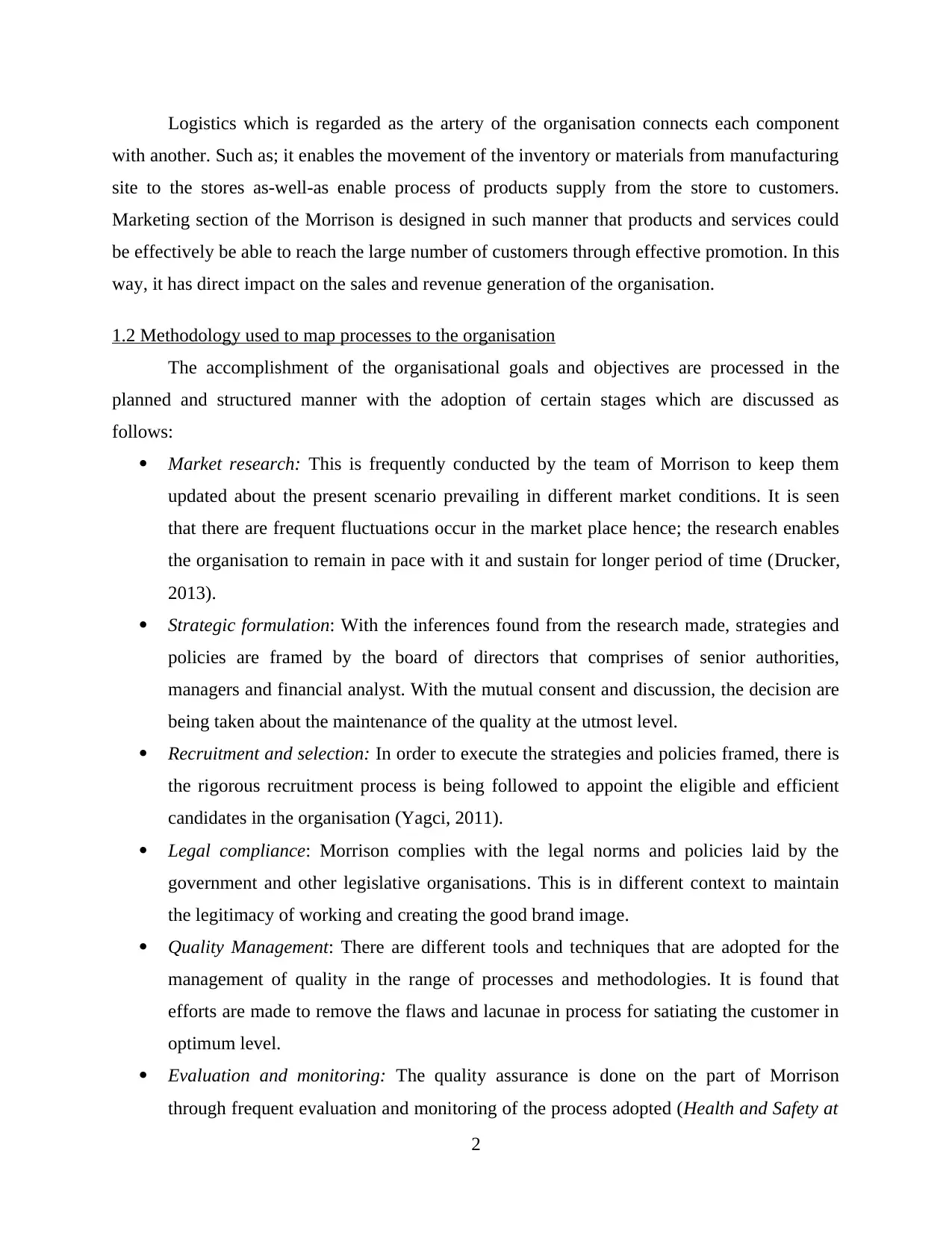
Logistics which is regarded as the artery of the organisation connects each component
with another. Such as; it enables the movement of the inventory or materials from manufacturing
site to the stores as-well-as enable process of products supply from the store to customers.
Marketing section of the Morrison is designed in such manner that products and services could
be effectively be able to reach the large number of customers through effective promotion. In this
way, it has direct impact on the sales and revenue generation of the organisation.
1.2 Methodology used to map processes to the organisation
The accomplishment of the organisational goals and objectives are processed in the
planned and structured manner with the adoption of certain stages which are discussed as
follows:
Market research: This is frequently conducted by the team of Morrison to keep them
updated about the present scenario prevailing in different market conditions. It is seen
that there are frequent fluctuations occur in the market place hence; the research enables
the organisation to remain in pace with it and sustain for longer period of time (Drucker,
2013).
Strategic formulation: With the inferences found from the research made, strategies and
policies are framed by the board of directors that comprises of senior authorities,
managers and financial analyst. With the mutual consent and discussion, the decision are
being taken about the maintenance of the quality at the utmost level.
Recruitment and selection: In order to execute the strategies and policies framed, there is
the rigorous recruitment process is being followed to appoint the eligible and efficient
candidates in the organisation (Yagci, 2011).
Legal compliance: Morrison complies with the legal norms and policies laid by the
government and other legislative organisations. This is in different context to maintain
the legitimacy of working and creating the good brand image.
Quality Management: There are different tools and techniques that are adopted for the
management of quality in the range of processes and methodologies. It is found that
efforts are made to remove the flaws and lacunae in process for satiating the customer in
optimum level.
Evaluation and monitoring: The quality assurance is done on the part of Morrison
through frequent evaluation and monitoring of the process adopted (Health and Safety at
2
with another. Such as; it enables the movement of the inventory or materials from manufacturing
site to the stores as-well-as enable process of products supply from the store to customers.
Marketing section of the Morrison is designed in such manner that products and services could
be effectively be able to reach the large number of customers through effective promotion. In this
way, it has direct impact on the sales and revenue generation of the organisation.
1.2 Methodology used to map processes to the organisation
The accomplishment of the organisational goals and objectives are processed in the
planned and structured manner with the adoption of certain stages which are discussed as
follows:
Market research: This is frequently conducted by the team of Morrison to keep them
updated about the present scenario prevailing in different market conditions. It is seen
that there are frequent fluctuations occur in the market place hence; the research enables
the organisation to remain in pace with it and sustain for longer period of time (Drucker,
2013).
Strategic formulation: With the inferences found from the research made, strategies and
policies are framed by the board of directors that comprises of senior authorities,
managers and financial analyst. With the mutual consent and discussion, the decision are
being taken about the maintenance of the quality at the utmost level.
Recruitment and selection: In order to execute the strategies and policies framed, there is
the rigorous recruitment process is being followed to appoint the eligible and efficient
candidates in the organisation (Yagci, 2011).
Legal compliance: Morrison complies with the legal norms and policies laid by the
government and other legislative organisations. This is in different context to maintain
the legitimacy of working and creating the good brand image.
Quality Management: There are different tools and techniques that are adopted for the
management of quality in the range of processes and methodologies. It is found that
efforts are made to remove the flaws and lacunae in process for satiating the customer in
optimum level.
Evaluation and monitoring: The quality assurance is done on the part of Morrison
through frequent evaluation and monitoring of the process adopted (Health and Safety at
2
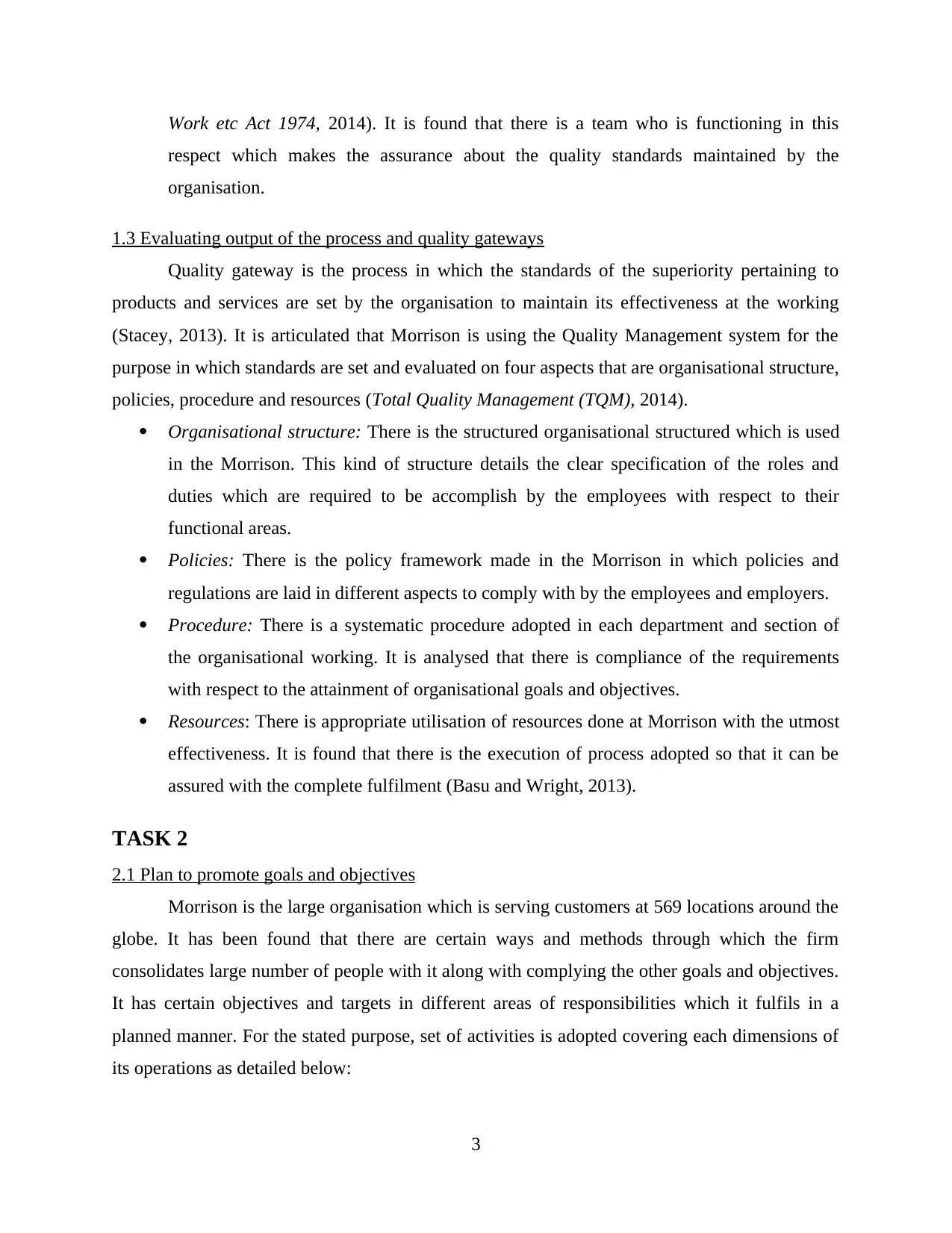
Work etc Act 1974, 2014). It is found that there is a team who is functioning in this
respect which makes the assurance about the quality standards maintained by the
organisation.
1.3 Evaluating output of the process and quality gateways
Quality gateway is the process in which the standards of the superiority pertaining to
products and services are set by the organisation to maintain its effectiveness at the working
(Stacey, 2013). It is articulated that Morrison is using the Quality Management system for the
purpose in which standards are set and evaluated on four aspects that are organisational structure,
policies, procedure and resources (Total Quality Management (TQM), 2014).
Organisational structure: There is the structured organisational structured which is used
in the Morrison. This kind of structure details the clear specification of the roles and
duties which are required to be accomplish by the employees with respect to their
functional areas.
Policies: There is the policy framework made in the Morrison in which policies and
regulations are laid in different aspects to comply with by the employees and employers.
Procedure: There is a systematic procedure adopted in each department and section of
the organisational working. It is analysed that there is compliance of the requirements
with respect to the attainment of organisational goals and objectives.
Resources: There is appropriate utilisation of resources done at Morrison with the utmost
effectiveness. It is found that there is the execution of process adopted so that it can be
assured with the complete fulfilment (Basu and Wright, 2013).
TASK 2
2.1 Plan to promote goals and objectives
Morrison is the large organisation which is serving customers at 569 locations around the
globe. It has been found that there are certain ways and methods through which the firm
consolidates large number of people with it along with complying the other goals and objectives.
It has certain objectives and targets in different areas of responsibilities which it fulfils in a
planned manner. For the stated purpose, set of activities is adopted covering each dimensions of
its operations as detailed below:
3
respect which makes the assurance about the quality standards maintained by the
organisation.
1.3 Evaluating output of the process and quality gateways
Quality gateway is the process in which the standards of the superiority pertaining to
products and services are set by the organisation to maintain its effectiveness at the working
(Stacey, 2013). It is articulated that Morrison is using the Quality Management system for the
purpose in which standards are set and evaluated on four aspects that are organisational structure,
policies, procedure and resources (Total Quality Management (TQM), 2014).
Organisational structure: There is the structured organisational structured which is used
in the Morrison. This kind of structure details the clear specification of the roles and
duties which are required to be accomplish by the employees with respect to their
functional areas.
Policies: There is the policy framework made in the Morrison in which policies and
regulations are laid in different aspects to comply with by the employees and employers.
Procedure: There is a systematic procedure adopted in each department and section of
the organisational working. It is analysed that there is compliance of the requirements
with respect to the attainment of organisational goals and objectives.
Resources: There is appropriate utilisation of resources done at Morrison with the utmost
effectiveness. It is found that there is the execution of process adopted so that it can be
assured with the complete fulfilment (Basu and Wright, 2013).
TASK 2
2.1 Plan to promote goals and objectives
Morrison is the large organisation which is serving customers at 569 locations around the
globe. It has been found that there are certain ways and methods through which the firm
consolidates large number of people with it along with complying the other goals and objectives.
It has certain objectives and targets in different areas of responsibilities which it fulfils in a
planned manner. For the stated purpose, set of activities is adopted covering each dimensions of
its operations as detailed below:
3
⊘ This is a preview!⊘
Do you want full access?
Subscribe today to unlock all pages.

Trusted by 1+ million students worldwide
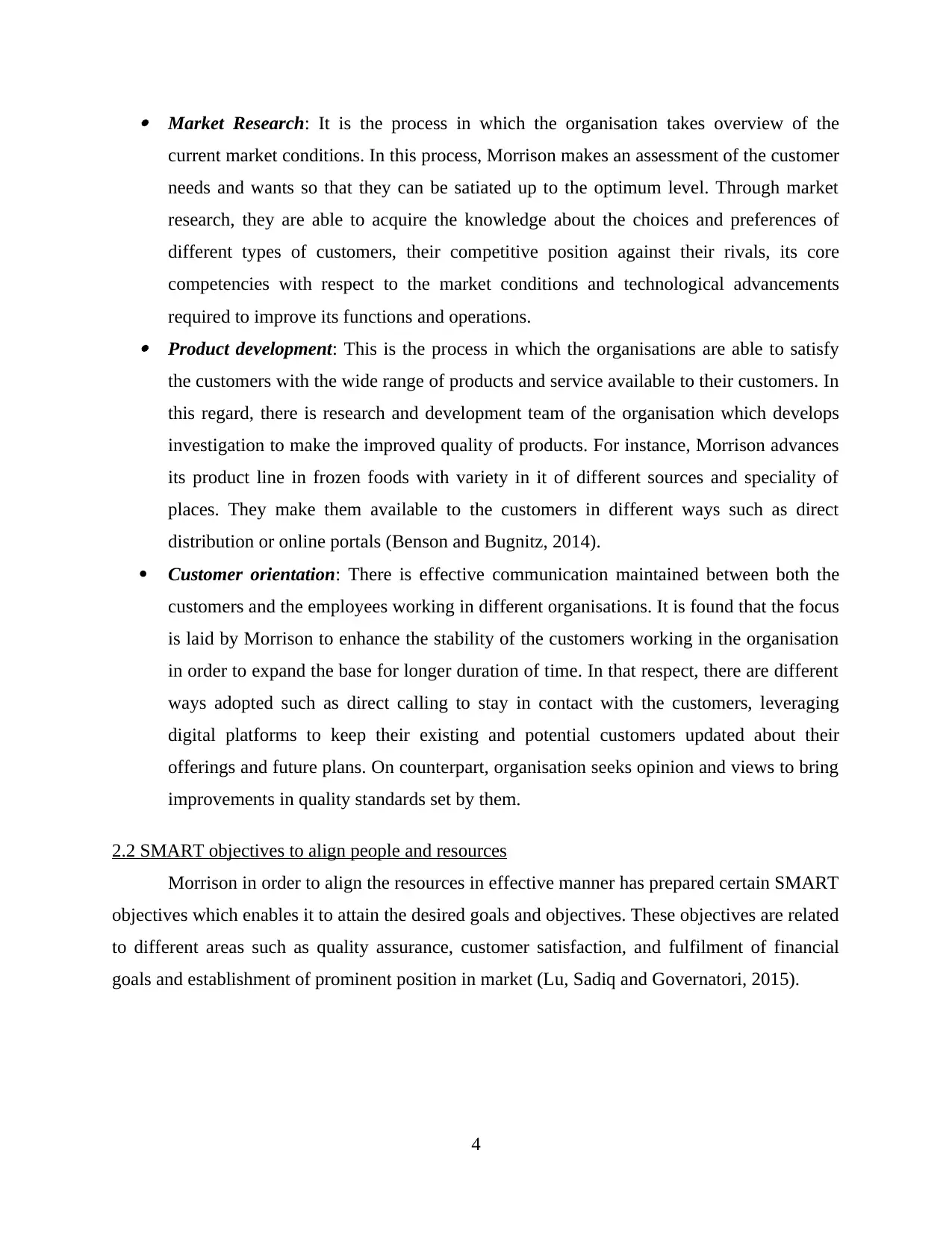
Market Research: It is the process in which the organisation takes overview of the
current market conditions. In this process, Morrison makes an assessment of the customer
needs and wants so that they can be satiated up to the optimum level. Through market
research, they are able to acquire the knowledge about the choices and preferences of
different types of customers, their competitive position against their rivals, its core
competencies with respect to the market conditions and technological advancements
required to improve its functions and operations. Product development: This is the process in which the organisations are able to satisfy
the customers with the wide range of products and service available to their customers. In
this regard, there is research and development team of the organisation which develops
investigation to make the improved quality of products. For instance, Morrison advances
its product line in frozen foods with variety in it of different sources and speciality of
places. They make them available to the customers in different ways such as direct
distribution or online portals (Benson and Bugnitz, 2014).
Customer orientation: There is effective communication maintained between both the
customers and the employees working in different organisations. It is found that the focus
is laid by Morrison to enhance the stability of the customers working in the organisation
in order to expand the base for longer duration of time. In that respect, there are different
ways adopted such as direct calling to stay in contact with the customers, leveraging
digital platforms to keep their existing and potential customers updated about their
offerings and future plans. On counterpart, organisation seeks opinion and views to bring
improvements in quality standards set by them.
2.2 SMART objectives to align people and resources
Morrison in order to align the resources in effective manner has prepared certain SMART
objectives which enables it to attain the desired goals and objectives. These objectives are related
to different areas such as quality assurance, customer satisfaction, and fulfilment of financial
goals and establishment of prominent position in market (Lu, Sadiq and Governatori, 2015).
4
current market conditions. In this process, Morrison makes an assessment of the customer
needs and wants so that they can be satiated up to the optimum level. Through market
research, they are able to acquire the knowledge about the choices and preferences of
different types of customers, their competitive position against their rivals, its core
competencies with respect to the market conditions and technological advancements
required to improve its functions and operations. Product development: This is the process in which the organisations are able to satisfy
the customers with the wide range of products and service available to their customers. In
this regard, there is research and development team of the organisation which develops
investigation to make the improved quality of products. For instance, Morrison advances
its product line in frozen foods with variety in it of different sources and speciality of
places. They make them available to the customers in different ways such as direct
distribution or online portals (Benson and Bugnitz, 2014).
Customer orientation: There is effective communication maintained between both the
customers and the employees working in different organisations. It is found that the focus
is laid by Morrison to enhance the stability of the customers working in the organisation
in order to expand the base for longer duration of time. In that respect, there are different
ways adopted such as direct calling to stay in contact with the customers, leveraging
digital platforms to keep their existing and potential customers updated about their
offerings and future plans. On counterpart, organisation seeks opinion and views to bring
improvements in quality standards set by them.
2.2 SMART objectives to align people and resources
Morrison in order to align the resources in effective manner has prepared certain SMART
objectives which enables it to attain the desired goals and objectives. These objectives are related
to different areas such as quality assurance, customer satisfaction, and fulfilment of financial
goals and establishment of prominent position in market (Lu, Sadiq and Governatori, 2015).
4
Paraphrase This Document
Need a fresh take? Get an instant paraphrase of this document with our AI Paraphraser
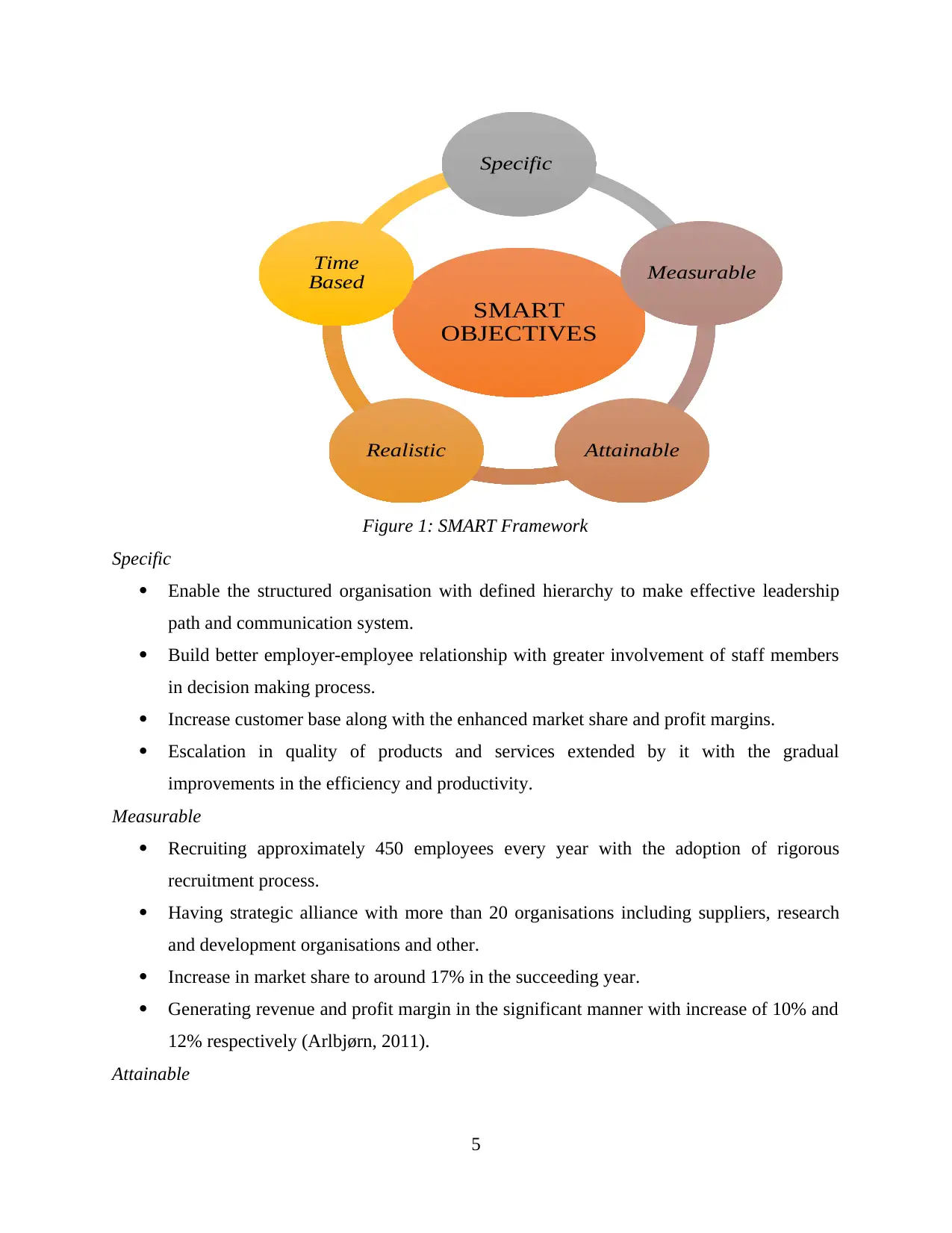
Figure 1: SMART Framework
Specific
Enable the structured organisation with defined hierarchy to make effective leadership
path and communication system.
Build better employer-employee relationship with greater involvement of staff members
in decision making process.
Increase customer base along with the enhanced market share and profit margins.
Escalation in quality of products and services extended by it with the gradual
improvements in the efficiency and productivity.
Measurable
Recruiting approximately 450 employees every year with the adoption of rigorous
recruitment process.
Having strategic alliance with more than 20 organisations including suppliers, research
and development organisations and other.
Increase in market share to around 17% in the succeeding year.
Generating revenue and profit margin in the significant manner with increase of 10% and
12% respectively (Arlbjørn, 2011).
Attainable
5
SMART
OBJECTIVES
Specific
Measurable
AttainableRealistic
Time
Based
Specific
Enable the structured organisation with defined hierarchy to make effective leadership
path and communication system.
Build better employer-employee relationship with greater involvement of staff members
in decision making process.
Increase customer base along with the enhanced market share and profit margins.
Escalation in quality of products and services extended by it with the gradual
improvements in the efficiency and productivity.
Measurable
Recruiting approximately 450 employees every year with the adoption of rigorous
recruitment process.
Having strategic alliance with more than 20 organisations including suppliers, research
and development organisations and other.
Increase in market share to around 17% in the succeeding year.
Generating revenue and profit margin in the significant manner with increase of 10% and
12% respectively (Arlbjørn, 2011).
Attainable
5
SMART
OBJECTIVES
Specific
Measurable
AttainableRealistic
Time
Based
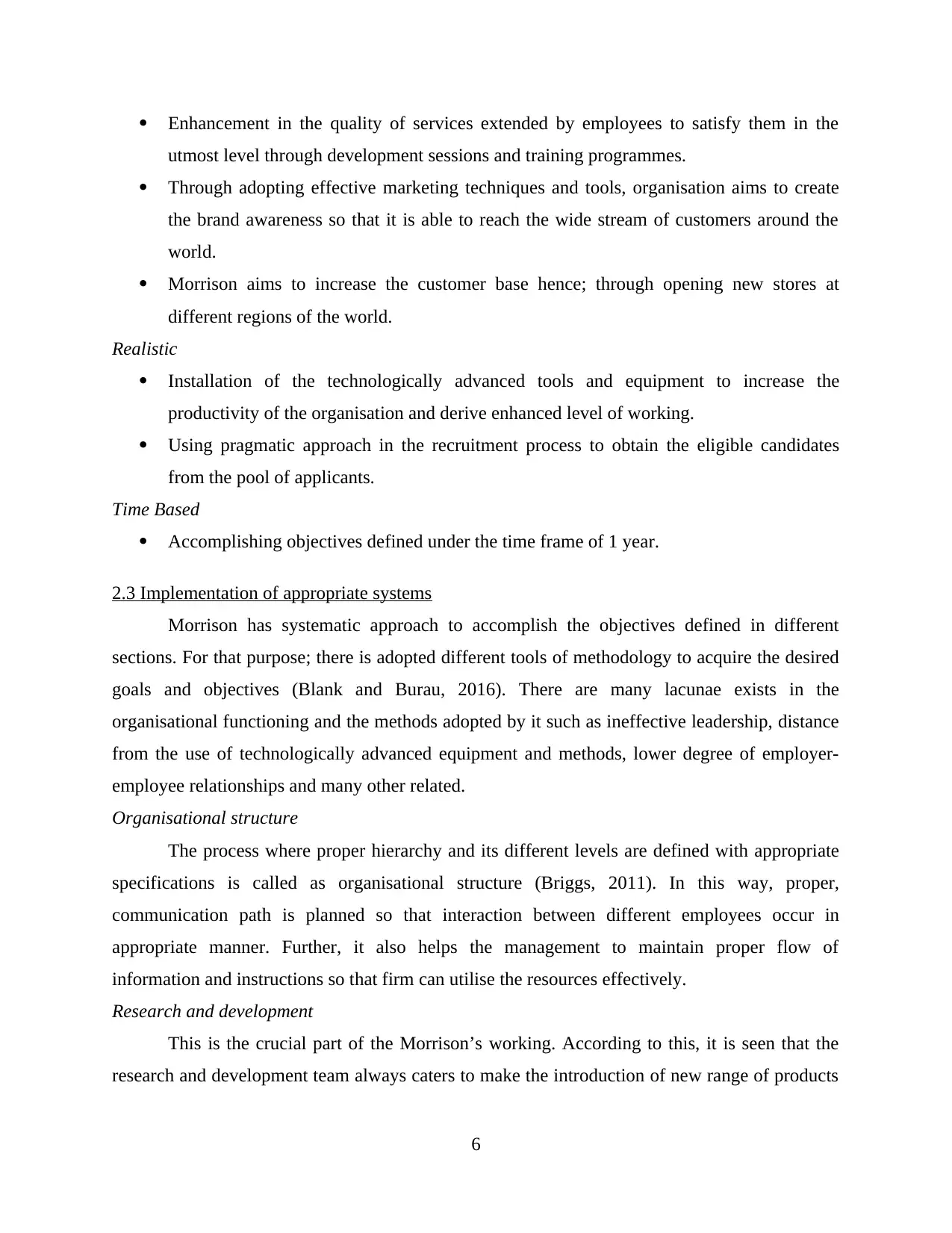
Enhancement in the quality of services extended by employees to satisfy them in the
utmost level through development sessions and training programmes.
Through adopting effective marketing techniques and tools, organisation aims to create
the brand awareness so that it is able to reach the wide stream of customers around the
world.
Morrison aims to increase the customer base hence; through opening new stores at
different regions of the world.
Realistic
Installation of the technologically advanced tools and equipment to increase the
productivity of the organisation and derive enhanced level of working.
Using pragmatic approach in the recruitment process to obtain the eligible candidates
from the pool of applicants.
Time Based
Accomplishing objectives defined under the time frame of 1 year.
2.3 Implementation of appropriate systems
Morrison has systematic approach to accomplish the objectives defined in different
sections. For that purpose; there is adopted different tools of methodology to acquire the desired
goals and objectives (Blank and Burau, 2016). There are many lacunae exists in the
organisational functioning and the methods adopted by it such as ineffective leadership, distance
from the use of technologically advanced equipment and methods, lower degree of employer-
employee relationships and many other related.
Organisational structure
The process where proper hierarchy and its different levels are defined with appropriate
specifications is called as organisational structure (Briggs, 2011). In this way, proper,
communication path is planned so that interaction between different employees occur in
appropriate manner. Further, it also helps the management to maintain proper flow of
information and instructions so that firm can utilise the resources effectively.
Research and development
This is the crucial part of the Morrison’s working. According to this, it is seen that the
research and development team always caters to make the introduction of new range of products
6
utmost level through development sessions and training programmes.
Through adopting effective marketing techniques and tools, organisation aims to create
the brand awareness so that it is able to reach the wide stream of customers around the
world.
Morrison aims to increase the customer base hence; through opening new stores at
different regions of the world.
Realistic
Installation of the technologically advanced tools and equipment to increase the
productivity of the organisation and derive enhanced level of working.
Using pragmatic approach in the recruitment process to obtain the eligible candidates
from the pool of applicants.
Time Based
Accomplishing objectives defined under the time frame of 1 year.
2.3 Implementation of appropriate systems
Morrison has systematic approach to accomplish the objectives defined in different
sections. For that purpose; there is adopted different tools of methodology to acquire the desired
goals and objectives (Blank and Burau, 2016). There are many lacunae exists in the
organisational functioning and the methods adopted by it such as ineffective leadership, distance
from the use of technologically advanced equipment and methods, lower degree of employer-
employee relationships and many other related.
Organisational structure
The process where proper hierarchy and its different levels are defined with appropriate
specifications is called as organisational structure (Briggs, 2011). In this way, proper,
communication path is planned so that interaction between different employees occur in
appropriate manner. Further, it also helps the management to maintain proper flow of
information and instructions so that firm can utilise the resources effectively.
Research and development
This is the crucial part of the Morrison’s working. According to this, it is seen that the
research and development team always caters to make the introduction of new range of products
6
⊘ This is a preview!⊘
Do you want full access?
Subscribe today to unlock all pages.

Trusted by 1+ million students worldwide
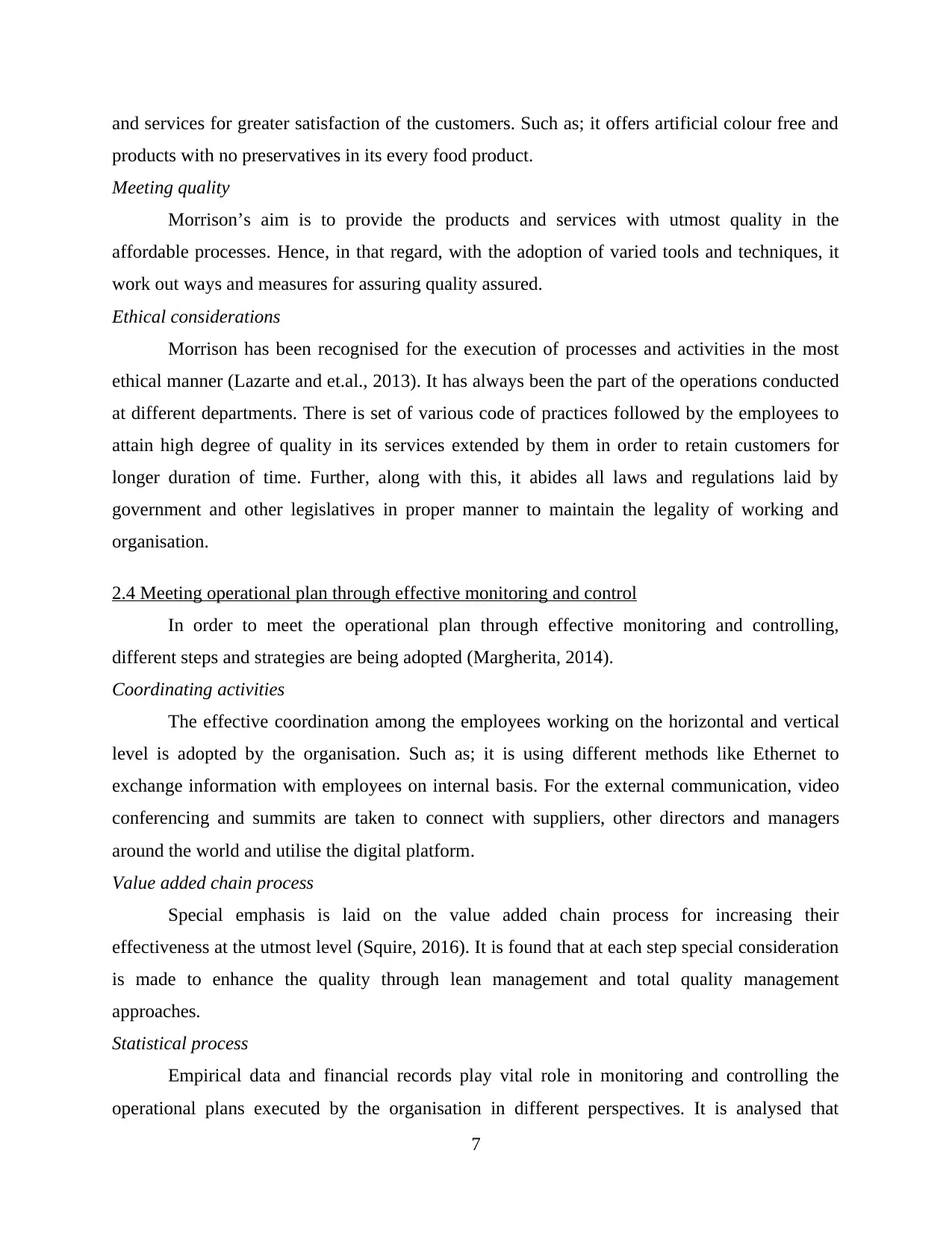
and services for greater satisfaction of the customers. Such as; it offers artificial colour free and
products with no preservatives in its every food product.
Meeting quality
Morrison’s aim is to provide the products and services with utmost quality in the
affordable processes. Hence, in that regard, with the adoption of varied tools and techniques, it
work out ways and measures for assuring quality assured.
Ethical considerations
Morrison has been recognised for the execution of processes and activities in the most
ethical manner (Lazarte and et.al., 2013). It has always been the part of the operations conducted
at different departments. There is set of various code of practices followed by the employees to
attain high degree of quality in its services extended by them in order to retain customers for
longer duration of time. Further, along with this, it abides all laws and regulations laid by
government and other legislatives in proper manner to maintain the legality of working and
organisation.
2.4 Meeting operational plan through effective monitoring and control
In order to meet the operational plan through effective monitoring and controlling,
different steps and strategies are being adopted (Margherita, 2014).
Coordinating activities
The effective coordination among the employees working on the horizontal and vertical
level is adopted by the organisation. Such as; it is using different methods like Ethernet to
exchange information with employees on internal basis. For the external communication, video
conferencing and summits are taken to connect with suppliers, other directors and managers
around the world and utilise the digital platform.
Value added chain process
Special emphasis is laid on the value added chain process for increasing their
effectiveness at the utmost level (Squire, 2016). It is found that at each step special consideration
is made to enhance the quality through lean management and total quality management
approaches.
Statistical process
Empirical data and financial records play vital role in monitoring and controlling the
operational plans executed by the organisation in different perspectives. It is analysed that
7
products with no preservatives in its every food product.
Meeting quality
Morrison’s aim is to provide the products and services with utmost quality in the
affordable processes. Hence, in that regard, with the adoption of varied tools and techniques, it
work out ways and measures for assuring quality assured.
Ethical considerations
Morrison has been recognised for the execution of processes and activities in the most
ethical manner (Lazarte and et.al., 2013). It has always been the part of the operations conducted
at different departments. There is set of various code of practices followed by the employees to
attain high degree of quality in its services extended by them in order to retain customers for
longer duration of time. Further, along with this, it abides all laws and regulations laid by
government and other legislatives in proper manner to maintain the legality of working and
organisation.
2.4 Meeting operational plan through effective monitoring and control
In order to meet the operational plan through effective monitoring and controlling,
different steps and strategies are being adopted (Margherita, 2014).
Coordinating activities
The effective coordination among the employees working on the horizontal and vertical
level is adopted by the organisation. Such as; it is using different methods like Ethernet to
exchange information with employees on internal basis. For the external communication, video
conferencing and summits are taken to connect with suppliers, other directors and managers
around the world and utilise the digital platform.
Value added chain process
Special emphasis is laid on the value added chain process for increasing their
effectiveness at the utmost level (Squire, 2016). It is found that at each step special consideration
is made to enhance the quality through lean management and total quality management
approaches.
Statistical process
Empirical data and financial records play vital role in monitoring and controlling the
operational plans executed by the organisation in different perspectives. It is analysed that
7
Paraphrase This Document
Need a fresh take? Get an instant paraphrase of this document with our AI Paraphraser
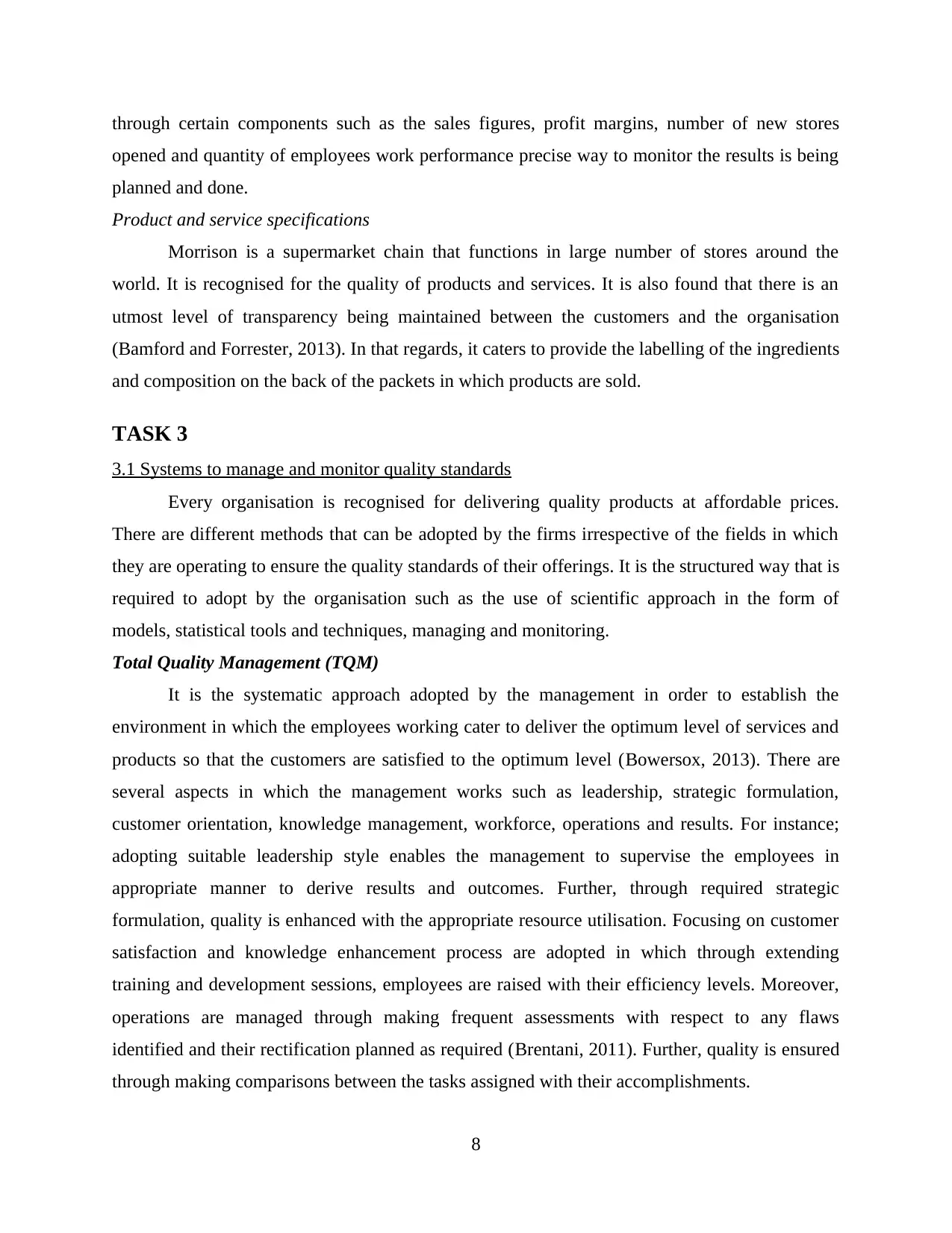
through certain components such as the sales figures, profit margins, number of new stores
opened and quantity of employees work performance precise way to monitor the results is being
planned and done.
Product and service specifications
Morrison is a supermarket chain that functions in large number of stores around the
world. It is recognised for the quality of products and services. It is also found that there is an
utmost level of transparency being maintained between the customers and the organisation
(Bamford and Forrester, 2013). In that regards, it caters to provide the labelling of the ingredients
and composition on the back of the packets in which products are sold.
TASK 3
3.1 Systems to manage and monitor quality standards
Every organisation is recognised for delivering quality products at affordable prices.
There are different methods that can be adopted by the firms irrespective of the fields in which
they are operating to ensure the quality standards of their offerings. It is the structured way that is
required to adopt by the organisation such as the use of scientific approach in the form of
models, statistical tools and techniques, managing and monitoring.
Total Quality Management (TQM)
It is the systematic approach adopted by the management in order to establish the
environment in which the employees working cater to deliver the optimum level of services and
products so that the customers are satisfied to the optimum level (Bowersox, 2013). There are
several aspects in which the management works such as leadership, strategic formulation,
customer orientation, knowledge management, workforce, operations and results. For instance;
adopting suitable leadership style enables the management to supervise the employees in
appropriate manner to derive results and outcomes. Further, through required strategic
formulation, quality is enhanced with the appropriate resource utilisation. Focusing on customer
satisfaction and knowledge enhancement process are adopted in which through extending
training and development sessions, employees are raised with their efficiency levels. Moreover,
operations are managed through making frequent assessments with respect to any flaws
identified and their rectification planned as required (Brentani, 2011). Further, quality is ensured
through making comparisons between the tasks assigned with their accomplishments.
8
opened and quantity of employees work performance precise way to monitor the results is being
planned and done.
Product and service specifications
Morrison is a supermarket chain that functions in large number of stores around the
world. It is recognised for the quality of products and services. It is also found that there is an
utmost level of transparency being maintained between the customers and the organisation
(Bamford and Forrester, 2013). In that regards, it caters to provide the labelling of the ingredients
and composition on the back of the packets in which products are sold.
TASK 3
3.1 Systems to manage and monitor quality standards
Every organisation is recognised for delivering quality products at affordable prices.
There are different methods that can be adopted by the firms irrespective of the fields in which
they are operating to ensure the quality standards of their offerings. It is the structured way that is
required to adopt by the organisation such as the use of scientific approach in the form of
models, statistical tools and techniques, managing and monitoring.
Total Quality Management (TQM)
It is the systematic approach adopted by the management in order to establish the
environment in which the employees working cater to deliver the optimum level of services and
products so that the customers are satisfied to the optimum level (Bowersox, 2013). There are
several aspects in which the management works such as leadership, strategic formulation,
customer orientation, knowledge management, workforce, operations and results. For instance;
adopting suitable leadership style enables the management to supervise the employees in
appropriate manner to derive results and outcomes. Further, through required strategic
formulation, quality is enhanced with the appropriate resource utilisation. Focusing on customer
satisfaction and knowledge enhancement process are adopted in which through extending
training and development sessions, employees are raised with their efficiency levels. Moreover,
operations are managed through making frequent assessments with respect to any flaws
identified and their rectification planned as required (Brentani, 2011). Further, quality is ensured
through making comparisons between the tasks assigned with their accomplishments.
8
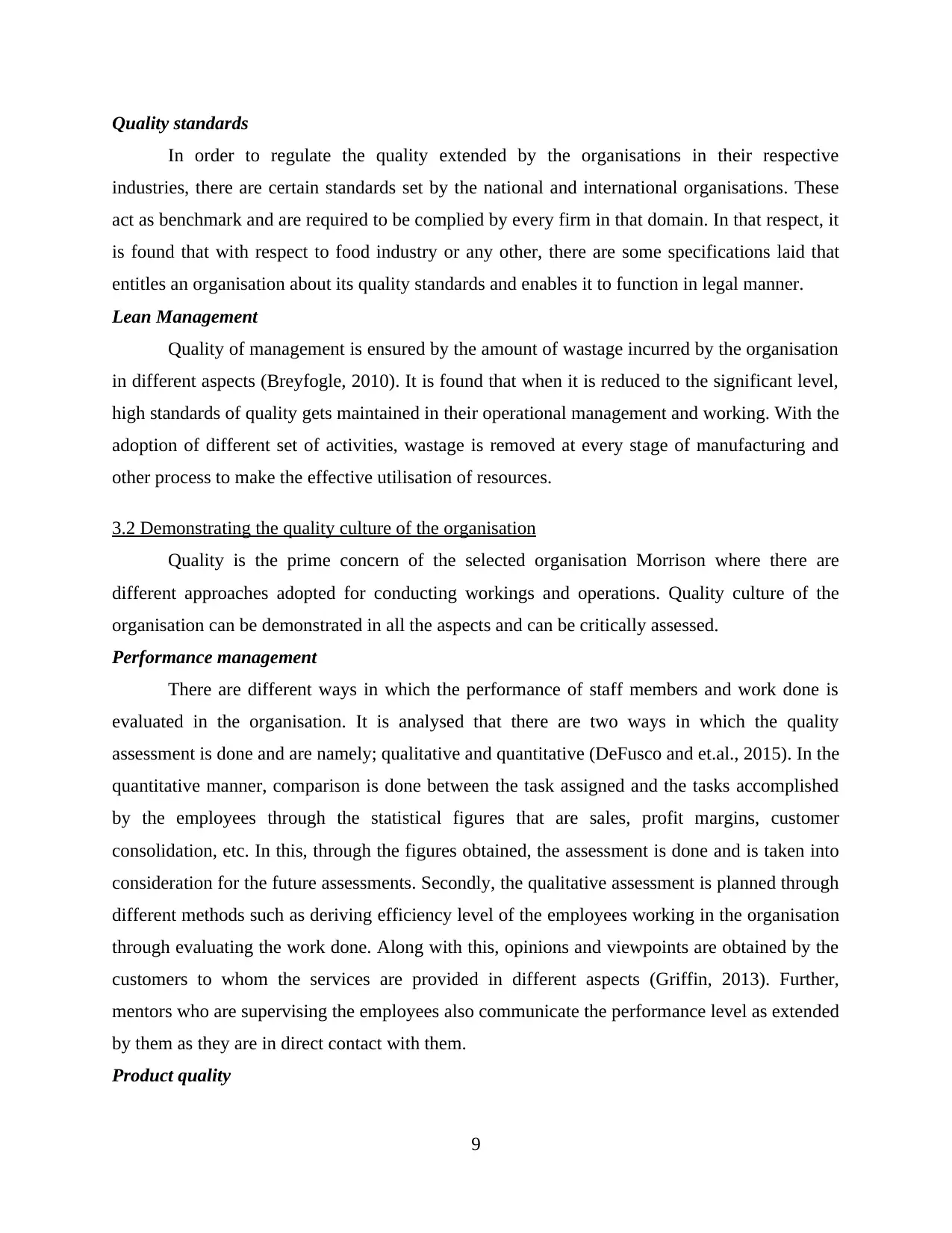
Quality standards
In order to regulate the quality extended by the organisations in their respective
industries, there are certain standards set by the national and international organisations. These
act as benchmark and are required to be complied by every firm in that domain. In that respect, it
is found that with respect to food industry or any other, there are some specifications laid that
entitles an organisation about its quality standards and enables it to function in legal manner.
Lean Management
Quality of management is ensured by the amount of wastage incurred by the organisation
in different aspects (Breyfogle, 2010). It is found that when it is reduced to the significant level,
high standards of quality gets maintained in their operational management and working. With the
adoption of different set of activities, wastage is removed at every stage of manufacturing and
other process to make the effective utilisation of resources.
3.2 Demonstrating the quality culture of the organisation
Quality is the prime concern of the selected organisation Morrison where there are
different approaches adopted for conducting workings and operations. Quality culture of the
organisation can be demonstrated in all the aspects and can be critically assessed.
Performance management
There are different ways in which the performance of staff members and work done is
evaluated in the organisation. It is analysed that there are two ways in which the quality
assessment is done and are namely; qualitative and quantitative (DeFusco and et.al., 2015). In the
quantitative manner, comparison is done between the task assigned and the tasks accomplished
by the employees through the statistical figures that are sales, profit margins, customer
consolidation, etc. In this, through the figures obtained, the assessment is done and is taken into
consideration for the future assessments. Secondly, the qualitative assessment is planned through
different methods such as deriving efficiency level of the employees working in the organisation
through evaluating the work done. Along with this, opinions and viewpoints are obtained by the
customers to whom the services are provided in different aspects (Griffin, 2013). Further,
mentors who are supervising the employees also communicate the performance level as extended
by them as they are in direct contact with them.
Product quality
9
In order to regulate the quality extended by the organisations in their respective
industries, there are certain standards set by the national and international organisations. These
act as benchmark and are required to be complied by every firm in that domain. In that respect, it
is found that with respect to food industry or any other, there are some specifications laid that
entitles an organisation about its quality standards and enables it to function in legal manner.
Lean Management
Quality of management is ensured by the amount of wastage incurred by the organisation
in different aspects (Breyfogle, 2010). It is found that when it is reduced to the significant level,
high standards of quality gets maintained in their operational management and working. With the
adoption of different set of activities, wastage is removed at every stage of manufacturing and
other process to make the effective utilisation of resources.
3.2 Demonstrating the quality culture of the organisation
Quality is the prime concern of the selected organisation Morrison where there are
different approaches adopted for conducting workings and operations. Quality culture of the
organisation can be demonstrated in all the aspects and can be critically assessed.
Performance management
There are different ways in which the performance of staff members and work done is
evaluated in the organisation. It is analysed that there are two ways in which the quality
assessment is done and are namely; qualitative and quantitative (DeFusco and et.al., 2015). In the
quantitative manner, comparison is done between the task assigned and the tasks accomplished
by the employees through the statistical figures that are sales, profit margins, customer
consolidation, etc. In this, through the figures obtained, the assessment is done and is taken into
consideration for the future assessments. Secondly, the qualitative assessment is planned through
different methods such as deriving efficiency level of the employees working in the organisation
through evaluating the work done. Along with this, opinions and viewpoints are obtained by the
customers to whom the services are provided in different aspects (Griffin, 2013). Further,
mentors who are supervising the employees also communicate the performance level as extended
by them as they are in direct contact with them.
Product quality
9
⊘ This is a preview!⊘
Do you want full access?
Subscribe today to unlock all pages.

Trusted by 1+ million students worldwide
1 out of 21
Related Documents
Your All-in-One AI-Powered Toolkit for Academic Success.
+13062052269
info@desklib.com
Available 24*7 on WhatsApp / Email
![[object Object]](/_next/static/media/star-bottom.7253800d.svg)
Unlock your academic potential
Copyright © 2020–2025 A2Z Services. All Rights Reserved. Developed and managed by ZUCOL.





